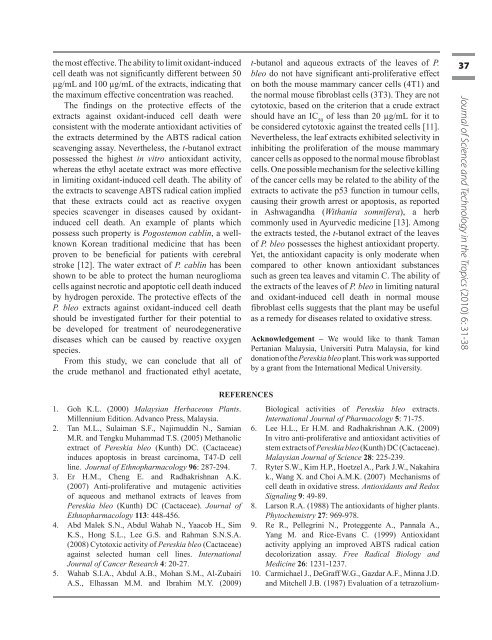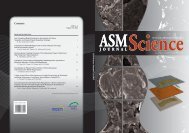Download - Akademi Sains Malaysia
Download - Akademi Sains Malaysia
Download - Akademi Sains Malaysia
Create successful ePaper yourself
Turn your PDF publications into a flip-book with our unique Google optimized e-Paper software.
the most effective. The ability to limit oxidant-induced<br />
cell death was not significantly different between 50<br />
µg/mL and 100 µg/mL of the extracts, indicating that<br />
the maximum effective concentration was reached.<br />
The findings on the protective effects of the<br />
extracts against oxidant-induced cell death were<br />
consistent with the moderate antioxidant activities of<br />
the extracts determined by the ABTS radical cation<br />
scavenging assay. Nevertheless, the t-butanol extract<br />
possessed the highest in vitro antioxidant activity,<br />
whereas the ethyl acetate extract was more effective<br />
in limiting oxidant-induced cell death. The ability of<br />
the extracts to scavenge ABTS radical cation implied<br />
that these extracts could act as reactive oxygen<br />
species scavenger in diseases caused by oxidantinduced<br />
cell death. An example of plants which<br />
possess such property is Pogostemon cablin, a wellknown<br />
Korean traditional medicine that has been<br />
proven to be beneficial for patients with cerebral<br />
stroke [12]. The water extract of P. cablin has been<br />
shown to be able to protect the human neuroglioma<br />
cells against necrotic and apoptotic cell death induced<br />
by hydrogen peroxide. The protective effects of the<br />
P. bleo extracts against oxidant-induced cell death<br />
should be investigated further for their potential to<br />
be developed for treatment of neurodegenerative<br />
diseases which can be caused by reactive oxygen<br />
species.<br />
From this study, we can conclude that all of<br />
the crude methanol and fractionated ethyl acetate,<br />
1. Goh K.L. (2000) <strong>Malaysia</strong>n Herbaceous Plants.<br />
Millennium Edition. Advanco Press, <strong>Malaysia</strong>.<br />
2.<br />
3.<br />
4.<br />
5.<br />
Tan M.L., Sulaiman S.F., Najimuddin N., Samian<br />
M.R. and Tengku Muhammad T.S. (2005) Methanolic<br />
extract of Pereskia bleo (Kunth) DC. (Cactaceae)<br />
induces apoptosis in breast carcinoma, T47-D cell<br />
line. Journal of Ethnopharmacology 96: 287-294.<br />
Er H.M., Cheng E. and Radhakrishnan A.K.<br />
(2007) Anti-proliferative and mutagenic activities<br />
of aqueous and methanol extracts of leaves from<br />
Pereskia bleo (Kunth) DC (Cactaceae). Journal of<br />
Ethnopharmacology 113: 448-456.<br />
Abd Malek S.N., Abdul Wahab N., Yaacob H., Sim<br />
K.S., Hong S.L., Lee G.S. and Rahman S.N.S.A.<br />
(2008) Cytotoxic activity of Pereskia bleo (Cactaceae)<br />
against selected human cell lines. International<br />
Journal of Cancer Research 4: 20-27.<br />
Wahab S.I.A., Abdul A.B., Mohan S.M., Al-Zubairi<br />
A.S., Elhassan M.M. and Ibrahim M.Y. (2009)<br />
REFERENCES<br />
t-butanol and aqueous extracts of the leaves of P.<br />
bleo do not have significant anti-proliferative effect<br />
on both the mouse mammary cancer cells (4T1) and<br />
the normal mouse fibroblast cells (3T3). They are not<br />
cytotoxic, based on the criterion that a crude extract<br />
should have an IC 50 of less than 20 µg/mL for it to<br />
be considered cytotoxic against the treated cells [11].<br />
Nevertheless, the leaf extracts exhibited selectivity in<br />
inhibiting the proliferation of the mouse mammary<br />
cancer cells as opposed to the normal mouse fibroblast<br />
cells. One possible mechanism for the selective killing<br />
of the cancer cells may be related to the ability of the<br />
extracts to activate the p53 function in tumour cells,<br />
causing their growth arrest or apoptosis, as reported<br />
in Ashwagandha (Withania somnifera), a herb<br />
commonly used in Ayurvedic medicine [13]. Among<br />
the extracts tested, the t-butanol extract of the leaves<br />
of P. bleo possesses the highest antioxidant property.<br />
Yet, the antioxidant capacity is only moderate when<br />
compared to other known antioxidant substances<br />
such as green tea leaves and vitamin C. The ability of<br />
the extracts of the leaves of P. bleo in limiting natural<br />
and oxidant-induced cell death in normal mouse<br />
fibroblast cells suggests that the plant may be useful<br />
as a remedy for diseases related to oxidative stress.<br />
Acknowledgement – We would like to thank Taman<br />
Pertanian <strong>Malaysia</strong>, Universiti Putra <strong>Malaysia</strong>, for kind<br />
donation of the Pereskia bleo plant. This work was supported<br />
by a grant from the International Medical University.<br />
6.<br />
7.<br />
8.<br />
9.<br />
Biological activities of Pereskia bleo extracts.<br />
International Journal of Pharmacology 5: 71-75.<br />
Lee H.L., Er H.M. and Radhakrishnan A.K. (2009)<br />
In vitro anti-proliferative and antioxidant activities of<br />
stem extracts of Pereskia bleo (Kunth) DC (Cactaceae).<br />
<strong>Malaysia</strong>n Journal of Science 28: 225-239.<br />
Ryter S.W., Kim H.P., Hoetzel A., Park J.W., Nakahira<br />
k., Wang X. and Choi A.M.K. (2007) Mechanisms of<br />
cell death in oxidative stress. Antioxidants and Redox<br />
Signaling 9: 49-89.<br />
Larson R.A. (1988) The antioxidants of higher plants.<br />
Phytochemistry 27: 969-978.<br />
Re R., Pellegrini N., Proteggente A., Pannala A.,<br />
Yang M. and Rice-Evans C. (1999) Antioxidant<br />
activity applying an improved ABTS radical cation<br />
decolorization assay. Free Radical Biology and<br />
Medicine 26: 1231-1237.<br />
Carmichael J., DeGraff W.G., Gazdar A.F., Minna J.D.<br />
and Mitchell J.B. (1987) Evaluation of a tetrazolium-<br />
Jostt vol 6.indd 37 7/22/10 10:09:17 PM<br />
10.<br />
37<br />
Journal of Science and Technology in the Tropics (2010) 6: 31-38

















